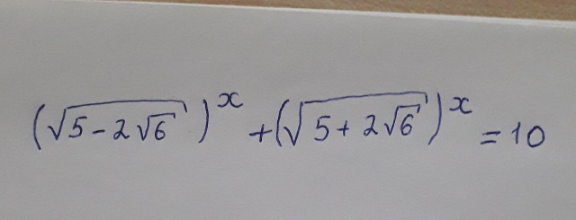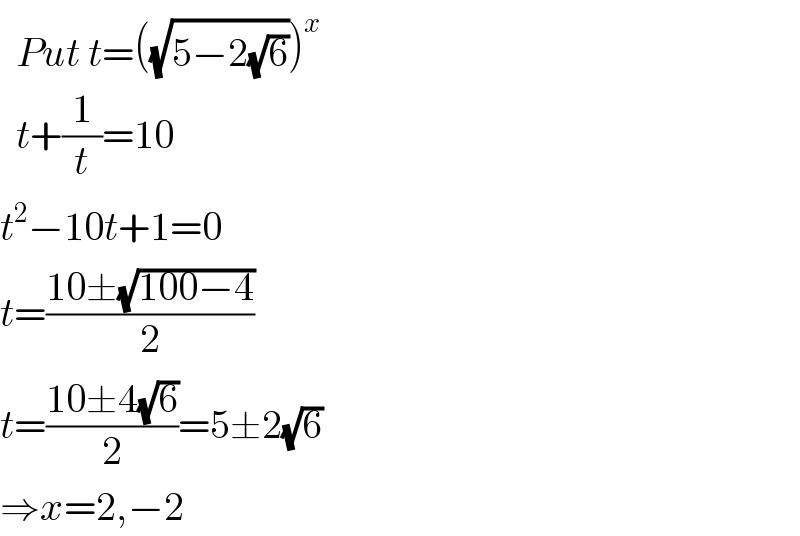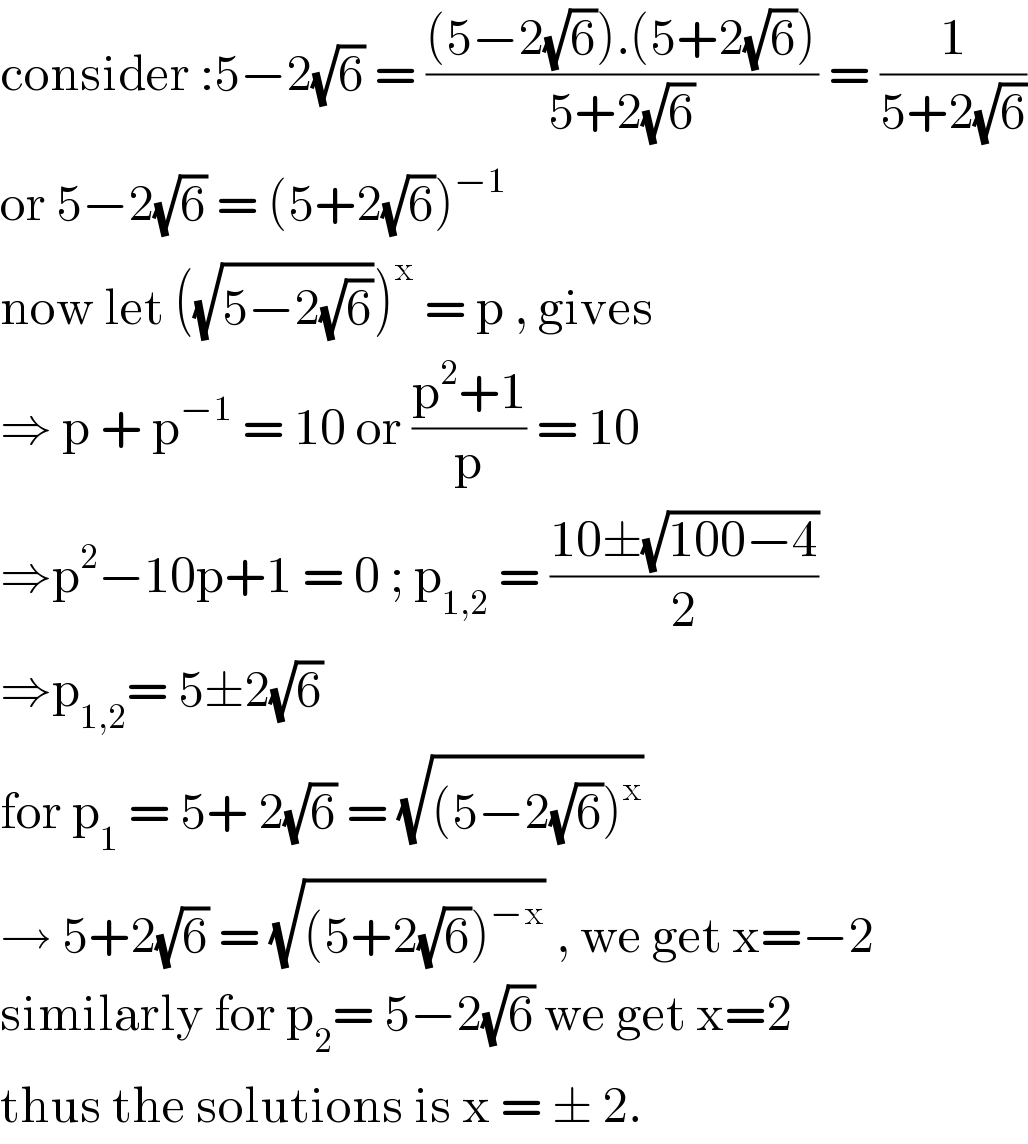Question Number 122360 by benjo_mathlover last updated on 16/Nov/20

Answered by $@y@m last updated on 16/Nov/20

$$\:\:{Put}\:{t}=\left(\sqrt{\mathrm{5}−\mathrm{2}\sqrt{\mathrm{6}}}\right)^{{x}} \\ $$$$\:\:{t}+\frac{\mathrm{1}}{{t}}=\mathrm{10} \\ $$$${t}^{\mathrm{2}} −\mathrm{10}{t}+\mathrm{1}=\mathrm{0} \\ $$$${t}=\frac{\mathrm{10}\pm\sqrt{\mathrm{100}−\mathrm{4}}}{\mathrm{2}} \\ $$$${t}=\frac{\mathrm{10}\pm\mathrm{4}\sqrt{\mathrm{6}}}{\mathrm{2}}=\mathrm{5}\pm\mathrm{2}\sqrt{\mathrm{6}} \\ $$$$\Rightarrow{x}=\mathrm{2},−\mathrm{2} \\ $$
Answered by nimnim last updated on 16/Nov/20

$${by}\:{inspection}\:{x}=\mathrm{2} \\ $$
Answered by liberty last updated on 16/Nov/20

$$\mathrm{consider}\::\mathrm{5}−\mathrm{2}\sqrt{\mathrm{6}}\:=\:\frac{\left(\mathrm{5}−\mathrm{2}\sqrt{\mathrm{6}}\right).\left(\mathrm{5}+\mathrm{2}\sqrt{\mathrm{6}}\right)}{\mathrm{5}+\mathrm{2}\sqrt{\mathrm{6}}}\:=\:\frac{\mathrm{1}}{\mathrm{5}+\mathrm{2}\sqrt{\mathrm{6}}} \\ $$$$\mathrm{or}\:\mathrm{5}−\mathrm{2}\sqrt{\mathrm{6}}\:=\:\left(\mathrm{5}+\mathrm{2}\sqrt{\mathrm{6}}\right)^{−\mathrm{1}} \\ $$$$\mathrm{now}\:\mathrm{let}\:\left(\sqrt{\mathrm{5}−\mathrm{2}\sqrt{\mathrm{6}}}\right)^{\mathrm{x}} \:=\:\mathrm{p}\:,\:\mathrm{gives} \\ $$$$\Rightarrow\:\mathrm{p}\:+\:\mathrm{p}^{−\mathrm{1}} \:=\:\mathrm{10}\:\mathrm{or}\:\frac{\mathrm{p}^{\mathrm{2}} +\mathrm{1}}{\mathrm{p}}\:=\:\mathrm{10} \\ $$$$\Rightarrow\mathrm{p}^{\mathrm{2}} −\mathrm{10p}+\mathrm{1}\:=\:\mathrm{0}\:;\:\mathrm{p}_{\mathrm{1},\mathrm{2}} \:=\:\frac{\mathrm{10}\pm\sqrt{\mathrm{100}−\mathrm{4}}}{\mathrm{2}} \\ $$$$\Rightarrow\mathrm{p}_{\mathrm{1},\mathrm{2}} =\:\mathrm{5}\pm\mathrm{2}\sqrt{\mathrm{6}} \\ $$$$\mathrm{for}\:\mathrm{p}_{\mathrm{1}} \:=\:\mathrm{5}+\:\mathrm{2}\sqrt{\mathrm{6}}\:=\:\sqrt{\left(\mathrm{5}−\mathrm{2}\sqrt{\mathrm{6}}\right)^{\mathrm{x}} } \\ $$$$\rightarrow\:\mathrm{5}+\mathrm{2}\sqrt{\mathrm{6}}\:=\:\sqrt{\left(\mathrm{5}+\mathrm{2}\sqrt{\mathrm{6}}\right)^{−\mathrm{x}} }\:,\:\mathrm{we}\:\mathrm{get}\:\mathrm{x}=−\mathrm{2} \\ $$$$\mathrm{similarly}\:\mathrm{for}\:\mathrm{p}_{\mathrm{2}} =\:\mathrm{5}−\mathrm{2}\sqrt{\mathrm{6}}\:\mathrm{we}\:\mathrm{get}\:\mathrm{x}=\mathrm{2} \\ $$$$\mathrm{thus}\:\mathrm{the}\:\mathrm{solutions}\:\mathrm{is}\:\mathrm{x}\:=\:\pm\:\mathrm{2}. \\ $$
